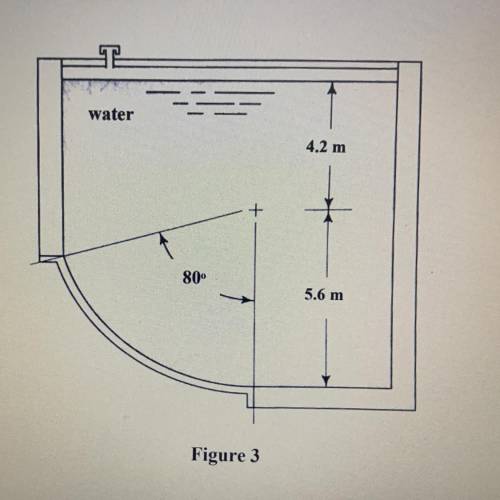
Engineering, 29.11.2021 17:40 sophie5064
Hydrostatic pressure is defined as the pressure exerted by a fluid at equilibrium at any point of time
due to the force of gravity. It is proportional to the depth measured from the surface as the weight
of the fluid increases when a downward force is applied. Figure 3 shows a tank holding a water
with its top surface open to the atmosphere. Part of the left wall is vertical, and the lower portion is
a segment of a cylinder. Width of the tank is 8 m long.
i)
Identify the depth from the water surface to the centroid of the projected area, he
[2 Marks]
ii)
Compute the magnitude of the horizontal component of the resultant force, FH
[4 Marks
111)
Calculate the magnitude of vertical component of the resultant force, Fy
[4 Marks]
iv)
Based on (ii) and (iii), determine the resultant force, FR
12 Marks]
v)
Compute the angle of inclination of the resultant force
vi)
12 Marks
Show the resultant force acting on the curved surface in such a direction that its line of action
passes through the center of curvature of the surface.
11 Mark!


Answers: 3


Another question on Engineering

Engineering, 04.07.2019 03:10
What precautions should you take to prevent injuries when dealing with heavy loads?
Answers: 1

Engineering, 04.07.2019 18:10
Refrigerant 134a enters an insulated compressor operating at steady state as saturated vapor at -26°c with a volumetric flow rate of 0.18 m3/s. refrigerant exits at 9 bar, 70°c. changes in kinetic and potential energy from inlet to exit can be ignored. determine the volumetric flow rate at the exit, in m3/s, and the compressor power, in kw.
Answers: 1

Engineering, 04.07.2019 18:10
Afluid flows with a velocity field given by v=(x/t)i.. determine the local and convective accelerations when x=3 and t=1.
Answers: 2

Engineering, 04.07.2019 18:10
Thermal stresses are developed in a metal when its a) initial temperature is changed b) final temperature is changed c) density is changed d) thermal deformation is prevented e) expansion is prevented f) contraction is prevented
Answers: 2
You know the right answer?
Hydrostatic pressure is defined as the pressure exerted by a fluid at equilibrium at any point of ti...
Questions




Mathematics, 12.04.2021 07:50

Mathematics, 12.04.2021 07:50

Mathematics, 12.04.2021 07:50


Mathematics, 12.04.2021 07:50

Health, 12.04.2021 07:50




Biology, 12.04.2021 07:50



Mathematics, 12.04.2021 07:50

Mathematics, 12.04.2021 07:50

Mathematics, 12.04.2021 07:50

Mathematics, 12.04.2021 07:50



